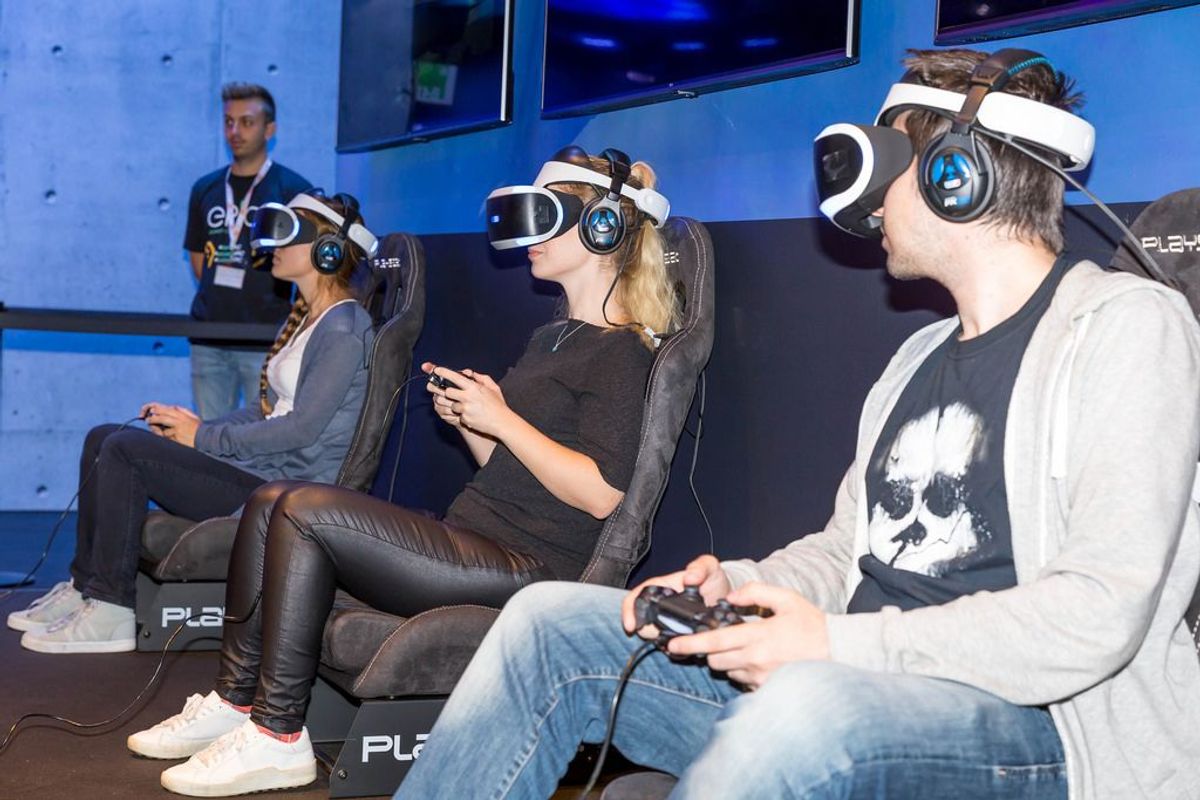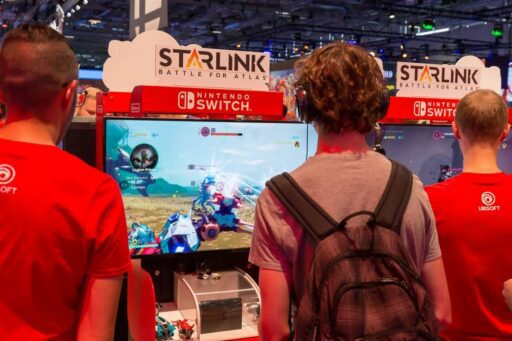The gaming landscape is undergoing a significant transformation with the emergence of multiplayer virtual reality (VR) games, marking the dawn of a new era in social gaming. As players around the world don VR headsets, they’re transported into immersive digital realms where they can interact with others in ways previously confined to the imagination. This article explores the multifaceted rise of multiplayer VR games, from the evolution of online communities to the social and cultural impacts of platforms like PSVR 2, and examines a case study of Among Us VR to understand the nuances of social gaming in virtual spaces.
Key Takeaways
- Multiplayer VR games are revolutionizing the concept of social gaming by providing immersive experiences that foster camaraderie and teamwork, creating a new dimension of multiplayer gaming.
- The integration of VR and AR technologies is blurring the lines between the physical and digital worlds, leading to innovative gameplay mechanics and interactive storytelling.
- PSVR 2 is contributing to the social and cultural evolution of gaming by building inclusive communities, enhancing accessibility, and impacting the rise of gaming influencers and esports celebrities.
- Among Us VR adapts a viral social phenomenon to the VR space, offering a new psychological thrill through social deduction while helping maintain social connections during times of physical distancing.
- The rise of multiplayer VR games presents both challenges and opportunities, including the need to balance engagement with mental health and the potential to create more inclusive and accessible gaming experiences.
A New Dimension of Multiplayer Gaming


The Evolution of Online Communities
The landscape of online gaming has undergone a profound transformation, evolving from the pixelated solo experiences of the past to the rich, social ecosystems we see today. Online gaming hubs like Xbox Live and Steam have been pivotal in this evolution, revolutionizing the way gamers connect, play, and share experiences.
- Early games like Halo: Combat Evolved and The Sims set new standards for gameplay and narrative complexity, offering players unprecedented freedom.
- The expansion of mobile gaming and the ubiquity of smartphones have further changed the gaming landscape, making games more accessible and social.
- Cutting-edge technologies such as AI, cloud gaming, VR, and AR continue to drive the market’s growth, enhancing the social aspect of gaming.
The incorporation of advanced technology has not only expanded the reach of digital games but has also fostered new forms of social interaction and community building within the gaming world.
Virtual Reality: Beyond the Screen
Virtual reality (VR) technology, coupled with high-speed internet connections, has ushered in a new era of immersive gameplay, enabling players to engage in truly authentic virtual worlds. The incorporation of stunning graphics and realistic simulations has elevated gaming experiences to new heights, captivating players with visually striking environments and lifelike interactions.
VR and AR technologies have not just revolutionized the gaming industry; they have redefined the very essence of interactive entertainment. By blurring the lines between the digital and physical worlds, these technologies offer a new realm of possibilities for players and developers alike.
The core technology behind VR game development includes VR headsets equipped with sensors, tracking systems, and high-resolution displays to create a sense of presence within a digital environment.
- Enhanced Immersion: VR and AR create highly immersive gaming experiences, making players feel as if they are indeed inside the game world.
- Innovative Interaction: New forms of interaction allow players to use natural movements and gestures, offering a more intuitive and engaging gameplay experience.
Fostering Teamwork and Camaraderie in VR
Virtual reality is revolutionizing the way we think about multiplayer gaming. Players can share virtual spaces, creating a sense of presence that goes beyond traditional gaming. This unique environment is ideal for fostering teamwork and camaraderie, as it allows players to interact in ways that feel more natural and intuitive.
The immersive nature of VR encourages players to collaborate and communicate effectively, building stronger social connections.
Here are some ways VR enhances teamwork:
- Encouraging cooperative problem-solving through shared challenges.
- Allowing for non-verbal communication cues, like gestures, to control the game.
- Providing realistic training and simulation environments for complex tasks.
These elements contribute to a more engaging and meaningful multiplayer experience, where players can form lasting bonds and work together towards common goals.
Challenges and Opportunities Ahead


Balancing Engagement and Mental Health
The allure of virtual reality games lies in their immersive nature, which can lead to prolonged periods of deep engagement. However, this engagement comes with a responsibility to consider the mental well-being of players. As VR games become more captivating, the line between healthy entertainment and excessive use blurs, potentially leading to isolation and neglect of real-world responsibilities.
It is critical to maintain a healthy balance and engage in appropriate gaming behaviors to ensure that the immersive world of VR does not overshadow the importance of real-world connections and duties.
To promote a balanced gaming lifestyle, developers and players alike must be aware of the potential risks. Ethical game design, moderation, and risk awareness are key to maintaining a healthy relationship with digital games. Educating players about responsible gaming and setting healthy boundaries are essential steps in fostering a sustainable gaming culture.
Table: Key Considerations for Balanced VR Gaming
| Factor | Description |
|---|---|
| Engagement | Ensure games capture attention without leading to compulsive behaviors. |
| Moderation | Promote time limits and breaks to prevent overuse. |
| Education | Inform players about the importance of balance and mental health. |
| Design | Create games that encourage real-world social interaction and responsibilities. |
The Role of Technology in Evolving Gameplay
The relentless march of technology has been a driving force in the evolution of gameplay, ushering in a Digital Renaissance in the gaming and tech industry. With each leap forward, from the pixelated adventures of yesteryear to the vast, open-world epics of today, technology has expanded the canvas upon which game developers can paint their masterpieces.
The integration of AI and VR has been particularly transformative, offering levels of engagement and immersion that were once the stuff of science fiction. AI-powered VR experiences, for example, bring to life NPCs with complex behaviors and traits, making each interaction within the virtual world more meaningful and unpredictable.
The following points highlight the pivotal role of technology in gaming:
- Advancements in graphics and processing power have led to more visually stunning and complex games.
- Developments in hardware and software enable more immersive and realistic experiences.
- Cloud gaming, streaming platforms, and subscription services provide new ways to access and enjoy games.
As we look to the future, the potential for technology to further revolutionize gameplay is boundless. The gaming landscape is poised for continued growth, driven by innovations that promise to redefine interactive entertainment.
Creating Inclusive and Accessible Gaming Experiences
In the pursuit of creating inclusive and accessible gaming experiences, developers are recognizing the importance of designing with all players in mind. Accessibility features not only aid gamers with disabilities but also enhance the overall player experience. For instance, customizable control schemes and adjustable difficulty levels allow for a more personalized and comfortable gaming session for everyone.
- Customizable control schemes
- Adjustable difficulty levels
- Subtitle and caption options
- Colorblind modes
- Assistive technologies integration
By integrating accessibility features from the outset, developers can ensure that their games are welcoming to a diverse audience, fostering a more inclusive gaming community.
It’s crucial to understand that accessibility in gaming is not just a niche requirement; it’s a standard that benefits the entire gaming population. As the UX Collective notes, features designed for accessibility are widely used by players of all abilities. This approach not only broadens the market reach for developers but also promotes a more equitable gaming landscape.
The Impact of Technology on Gaming Platforms


The Convergence of AR and VR in Gaming
The gaming industry is witnessing a transformative phase with the convergence of AR and VR technologies, creating a new frontier for interactive experiences. This fusion is not just enhancing the immersion of gaming environments but is also introducing innovative ways for players to interact within these spaces.
- Enhanced Immersion: By integrating the physical world with digital overlays, AR brings a unique dimension to gaming, while VR envelops players in a completely virtual world.
- Innovative Interaction: The combination of AR and VR allows for natural movements and gestures, offering a more intuitive gameplay experience.
The potential of AR and VR to revolutionize gaming is underscored by their ability to blur the lines between the digital and physical worlds. As these technologies become more sophisticated, they pave the way for new forms of storytelling and player engagement, setting the stage for a future where gaming is more interactive and immersive than ever before.
The seamless integration of AR and VR is poised to redefine the very nature of gaming, offering a hybrid environment that leverages the strengths of both technologies.
Interactive Storytelling and Gameplay Mechanics
The advent of VR has revolutionized the way stories are told and games are played. Developers are exploring unique mechanics and gameplay elements specific to VR, enhancing the immersive experience. Collaborative storytelling in multiplayer VR games allows players to share the narrative, creating a personalized and dynamic journey.
- Expanded Creativity: VR and AR technologies have unlocked new possibilities for game designers to innovate beyond traditional boundaries.
- Procedural Generation: Dynamic narratives and quests adapt to player actions, offering a fresh experience with each playthrough.
- Intuitive Controls: Using natural gestures, players can interact with the game world in a more engaging way.
To ensure a balanced and enriching experience, game designers are encouraged to integrate clear goals, support social interaction, and promote digital wellness.
The evolution of interactive storytelling can be traced back to the introduction of narratives in the 1990s, which captivated audiences with new and exciting possibilities. Today, the convergence of VR and AR is transforming gaming hubs and online interactions, paving the way for a future where gameplay and storytelling are seamlessly intertwined.
The Transformation of Gaming Hubs and Online Interaction
The landscape of gaming hubs and online interaction has undergone a profound metamorphosis, driven by the relentless pace of technological innovation. The integration of VR and AR is redefining the way gamers connect, play, and share experiences. This fusion has given rise to virtual spaces that are more immersive and interactive than ever before, blurring the lines between the digital and physical worlds.
- Virtual lobbies have evolved into expansive, social environments where players can meet, socialize, and form lasting friendships.
- In-game communication tools have become more sophisticated, allowing for nuanced expressions and interactions.
- The rise of cloud gaming platforms has facilitated seamless, cross-platform play, expanding the potential for global connectivity.
The future of online gaming is not just about the games themselves, but the rich communities and connections they foster. The combination of VR and AR technologies opens up exciting possibilities for multiplayer gaming, revolutionizing the way we think about online spaces and how we interact within them.
The Social and Cultural Impact of PSVR 2


Building Communities and Connections
The advent of PSVR 2 marks a significant leap in how gamers interact and bond within virtual spaces. From chat boxes to VR rooms created for relaxation and conversation, a social VR game builds relationships so that you can share strategies and forge alliances, transforming solitary gaming into a collective experience.
- Engaging with others in the gaming community adds a layer of excitement to both PC and mobile gaming.
- Multiplayer experiences often cultivate a sense of camaraderie and healthy competition among players.
- Whether teaming up in mobile battle royales or conquering quests in PC MMORPGs, the social aspect enriches the overall gaming experience.
The PSVR 2 environment fosters communication, cooperation, and social skills, offering a way for people with similar interests to connect, share stories, and build relationships.
Despite the challenges, these virtual communities have become havens, allowing players to stay connected while practicing physical distancing. They serve as a valuable resource, providing a break from reality and promoting mental health.
The Rise of Gaming Influencers and Esports Celebrities
The gaming landscape has been dramatically reshaped by the emergence of influencer celebrities and esports athletes. These individuals have transcended the traditional boundaries of gaming to become cultural icons, leveraging platforms like Twitch and YouTube to reach millions. Their influence is not limited to entertainment; they shape game trends, drive sales, and even impact game development.
- Gaming influencers and esports professionals
- Content creation and live streaming
- Cultural impact and trendsetting
The competitive scene has also seen a meteoric rise, with esports becoming a legitimate career path. Tournaments now boast substantial prize pools and draw audiences that rival traditional sports events. This has not only provided gamers with opportunities for professional advancement, but it has also created a new ecosystem of sponsors, coaches, and support staff.
The symbiotic relationship between gaming influencers and their communities has become a cornerstone of the industry, fostering a new era of social gaming that extends well beyond the screen.
Inclusivity and Accessibility in Virtual Reality Gaming
The advent of VR technology has not only revolutionized the way we play games but also opened doors to make gaming experiences more interactive and accessible. With the potential to aid inclusion, companies like Telef\u00f3nica are spearheading initiatives to provide accessible and personalized mixed reality experiences, enhancing connection and entertainment for all users.
In the realm of VR, inclusivity extends beyond the game content to the very interfaces that players interact with. Developers are now tasked with creating control schemes that are adaptable to a wide range of physical abilities, ensuring that everyone can participate in the virtual world. This commitment to accessibility is reflected in the design of user interfaces, audio descriptions, and customizable settings that cater to various needs.
The challenge of inclusivity in VR gaming is not just about technology; it’s about creating experiences that everyone can enjoy, regardless of their physical or cognitive abilities.
As we look to the future, the role of VR in fostering an inclusive gaming environment is clear. It’s not just about playing a game; it’s about building a space where everyone feels welcome and empowered to explore new worlds and experiences together.
Among Us VR: A Case Study in Social Gaming


Adapting a Viral Phenomenon to Virtual Reality
The transition of Among Us from a simple screen-based game to a fully immersive virtual reality experience marks a significant milestone in social gaming. The original game, which gained explosive popularity during the pandemic, has been transformed into Among Us VR, released on November 10, 2022, offering a new, intense first-person perspective.
The essence of the game remains unchanged, yet the VR adaptation amplifies the suspense and interaction, as players can now hear the subtle sounds of an impostor venting or the clicks of a puzzle being solved in engineering.
The adaptation process involved not only a shift in perspective but also a reimagining of the game’s mechanics to suit the VR environment. Here are some key aspects of the transition:
- Integration of VR-specific controls and interactions
- Enhancement of audio and visual cues for a more immersive experience
- Re-design of game environments to accommodate 360-degree exploration
This evolution of Among Us into VR is a testament to the game’s enduring appeal and the potential for classic games to find new life in the realm of virtual reality.
The Psychological Thrill of Social Deduction in VR
The transition of social deduction games like Among Us to virtual reality has introduced a new level of psychological engagement. The immersive nature of VR heightens the tension and paranoia as players attempt to uncover the impostor among them. The first-person perspective and spatial audio cues, such as the sound of an impostor venting, create a palpable sense of presence and urgency that traditional screen-based gaming cannot match.
In VR, every whispered accusation and defense becomes more consequential, as players are not just observers but active participants in a high-stakes game of trust and deception.
The following points highlight the unique aspects of social deduction in VR:
- Enhanced immersion through VR’s sensory capabilities
- Increased emotional investment due to the first-person perspective
- The need for heightened communication and observation skills
- The thrill of solving puzzles under pressure, akin to defusing a bomb in VR
These elements combine to deliver an experience that is not only entertaining but also mentally stimulating, as players must navigate complex social dynamics and make critical decisions with limited information.
Maintaining Social Connections Through Gaming
In the era of virtual reality, games like Among Us VR are not just about entertainment; they are about maintaining social connections in a world where physical proximity is no longer a prerequisite for social interaction. The immersive nature of VR allows players to feel a sense of presence, making the virtual gatherings feel almost as real as face-to-face meetings.
The essence of multiplayer VR games lies in their ability to simulate real-world social dynamics within a digital space. This simulation is crucial for preserving the social fabric that binds communities together, even when they are miles apart.
While VR gaming offers a plethora of opportunities for social interaction, it is important to balance virtual and real-world connections. Responsible gaming practices and setting healthy boundaries are essential to ensure that the digital world complements rather than replaces our real-world social lives. Here are some key points to consider for maintaining social connections through gaming:
- Prioritize real-world responsibilities and relationships
- Set clear boundaries for gaming time to prevent isolation
- Use gaming as a platform for communication and cooperation
- Recognize the emotional benefits of gaming, such as stress relief and emotional bonding
Embracing the Future of Social Gaming
As we witness the evolution of multiplayer VR games, it’s clear that we are entering a new era of social gaming that transcends traditional boundaries. The immersive experiences offered by platforms like PSVR 2 not only redefine the concept of multiplayer gaming but also enhance the social fabric of the gaming community. By fostering camaraderie, teamwork, and emotional connections, VR games are creating profound and meaningful shared experiences. The rise of social gaming phenomena like Among Us VR exemplifies the potential for virtual worlds to bring people together, even when they are physically apart. While challenges such as maintaining mental health in the face of excessive gaming remain, the opportunities for connection, personal growth, and cultural impact are immense. As technology continues to advance, we can expect multiplayer VR games to further shape the social and cultural landscape, offering new dimensions of interaction and community-building that will enrich the lives of gamers worldwide.
Frequently Asked Questions
How is PSVR 2 changing the concept of multiplayer gaming?
PSVR 2 is enhancing multiplayer gaming by offering a level of presence and interaction unmatched by traditional gaming. It allows players to share virtual spaces as if they were physically together, which fosters a sense of camaraderie and teamwork, creating more immersive and meaningful shared experiences.
What are the social aspects of gaming that PSVR 2 is impacting?
PSVR 2 impacts gaming as a social phenomenon by fostering friendships, building online communities, and providing a sense of belonging. It also highlights the rise of gaming influencers, esports athletes, and content creators who have become cultural icons within the gaming community.
How are AR and VR technologies reshaping the gaming landscape?
AR and VR technologies are providing immersive gameplay experiences that blur the lines between physical and digital worlds. They introduce new possibilities for interactive storytelling and gameplay mechanics, expanding beyond traditional gaming formats.
How does PSVR 2 contribute to inclusivity and accessibility in gaming?
PSVR 2 contributes to inclusivity and accessibility by offering features like customizable control schemes and adjustable comfort settings. This ensures that a wider audience, including those with different abilities, can enjoy the immersive VR experiences it offers.
What is Among Us VR and how does it differ from the original game?
Among Us VR is a virtual reality adaptation of the popular social deduction game Among Us. The key difference is the first-person perspective in VR, which intensifies the experience and adds a new layer of tension as players try to complete tasks and identify impostors.
How have multiplayer VR games impacted mental health during the pandemic?
Multiplayer VR games have helped people stay connected while practicing physical distancing, providing a platform for friends and family to gather virtually and create shared experiences. Online gaming communities have supported mental health by offering a break from reality, though excessive gaming has also had harmful effects on mental well-being.





